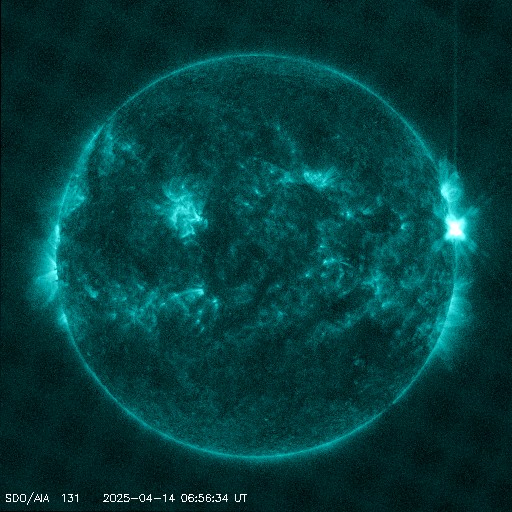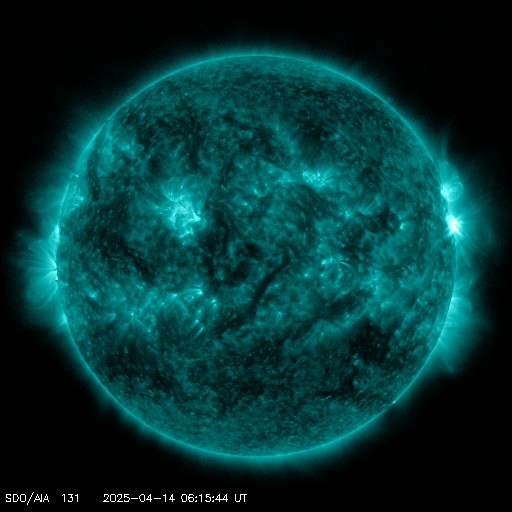Viewing archive of Sunday, 25 September 2011
Solar activity report
Any mentioned solar flare in this report has a scaling factor applied by the Space Weather Prediction Center (SWPC). Because of the SWPC scaling factor, solar flares are reported as 42% smaller than for the science quality data. The scaling factor has been removed from our archived solar flare data to reflect the true physical units.
Report of Solar-Geophysical Activity 2011 Sep 25 2235 UTCPrepared by the NOAA © SWPC and processed by SpaceWeatherLive.com
Joint USAF/NOAA Report of Solar and Geophysical Activity
::::::::::CORRECTED COPY:::::::::: SDF Number 268 Issued at 2200Z on 25 Sep 2011IA. Analysis of Solar Active Regions and Activity from 24-2100Z to 25-2100Z
Solar activity was high. Regions 1302 (N12E36) and
1303 (S28W79) each produced three M-class flares. The largest was
an M7/2N at 25/0450Z. A partial halo CME was observed at 24/1936Z
in LASCO C2 imagery which was likely associated with the M3 flare
from Region 1302 that occurred at 24/1921Z. The event had an
associated Type II (1369 km/s) and an approximate plane of sky speed
of 800 km/s using LASCO C3 imagery. The majority of the ejecta was
directed off the North East limb. Two more CMEs were observed at
25/0236Z and 25/0312Z off the Southwest limb in LASCO C2 imagery,
however, they are not expected to be geoeffective.
IB. Solar Activity Forecast
Solar activity is expected to continue
at high levels with a chance for isolated X-class flares from Region
1302.
IIA. Geophysical Activity Summary 24-2100Z to 25-2100Z
The geomagnetic field was mostly quiet. At approximately 25/1106Z,
the IMF Bt increased from 5 nT to 10 nT while the field
density increased to around 7 p/cc at the ACE spacecraft. A sudden
impulse (14 nT) was observed in the Boulder magnetometer at 25/1151Z.
The greater than 10 MeV proton event that began at 23/2255Z, reached
a peak of 27.3 PFUs at 25/2030Z, and continues to remain above the
10 PFU threshold.
IIB. Geophysical Activity Forecast
The geomagnetic field is
expected to be at unsettled to minor storm conditions with major
storm periods possible at high latitudes on day 1 (26 September) due
to activity from the CME associated with the M7 flare that occurred
at 24/1320Z. Mostly unsettled conditions are expected on days 2-3
(27-28 September) due to continued activity from the CME as well as
a possible glancing blow from a weak CME on day 3. The greater than
10 MeV proton flux is expected to continue to remain above threshold
for the next three days.
III. Event Probabilities 26 Sep to 28 Sep
| Class M | 80% | 80% | 80% |
| Class X | 40% | 40% | 40% |
| Proton | 99% | 99% | 80% |
| PCAF | yellow | ||
IV. Penticton 10.7 cm Flux
Observed 25 Sep 169 Predicted 26 Sep-28 Sep 170/170/170 90 Day Mean 25 Sep 108
V. Geomagnetic A Indices
Observed Afr/Ap 24 Sep 003/004 Estimated Afr/Ap 25 Sep 007/007 Predicted Afr/Ap 26 Sep-28 Sep 025/030-012/012-008/015
VI. Geomagnetic Activity Probabilities 26 Sep to 28 Sep
| A. Middle Latitudes | |||
|---|---|---|---|
| Active | 45% | 30% | 15% |
| Minor storm | 20% | 15% | 05% |
| Major-severe storm | 10% | 05% | 01% |
| B. High Latitudes | |||
|---|---|---|---|
| Active | 45% | 30% | 35% |
| Minor storm | 25% | 15% | 15% |
| Major-severe storm | 15% | 05% | 05% |
All times in UTC
Current data suggests there is a slight possibility for aurora to appear at the following high latitude regions in the near future
NuukReykjavik
Latest news
Latest forum messages
2025/04/12-13 Filament CMEs 2025/04/16 G2 Watch 39AR 4055 99Incoming & Unnumbered Active Regions 1700Unspecified geomagnetic activity 2258Potential AR4062 8
More topicsSupport SpaceWeatherLive.com!
A lot of people come to SpaceWeatherLive to follow the Sun's activity or if there is aurora to be seen, but with more traffic comes higher server costs. Consider a donation if you enjoy SpaceWeatherLive so we can keep the website online!

Latest alerts
Monday, 14 April 2025
23:15 UTC - Geomagnetic activity
Active geomagnetic conditions (Kp4) Threshold Reached: 23:01 UTC
07:09 UTC - Solar flare
Moderate M4.28 flare from sunspot region 4055
06:48 UTC - Radio Blackout
Minor R1 radio blackout in progress (≥M1 - current: M1.53)
06:24 UTC - Solar flare
Moderate M1.49 flare from sunspot region 4055
06:06 UTC - Radio Blackout
Minor R1 radio blackout in progress (≥M1 - current: M1.16)
Space weather facts
| Last X-flare | 2025/03/28 | X1.1 |
| Last M-flare | 2025/04/14 | M4.2 |
| Last geomagnetic storm | 2025/04/06 | Kp5 (G1) |
| Spotless days | |
|---|---|
| Last spotless day | 2022/06/08 |
| Monthly mean Sunspot Number | |
|---|---|
| March 2025 | 134.2 -20.4 |
| April 2025 | 132.1 -2.1 |
| Last 30 days | 130.6 -13.6 |





